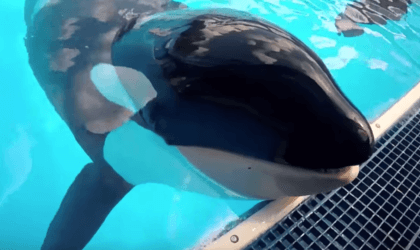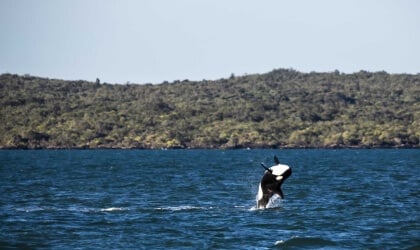Self-isolation, self-quarantine, social distancing, personal freedom—ever since the outbreak of COVID-19 (the novel coronavirus whose origin has been traced back to humans’ practice of eating animals), these phrases have become buzzwords. But while the experience of a quarantine is new to most of us, being isolated, trapped, and fearful is nothing new for the animals held captive at SeaWorld parks. So now that SeaWorld has temporarily shut down because of the coronavirus crisis, we’re urging the abusement park not to reopen unless it sends the dolphins and whales there to seaside sanctuaries and ends its use of animals. And we want you to join us.
Our self-isolation to prevent the spread of the coronavirus is nothing compared to the forced isolation endured by whales, orcas, and other dolphins at SeaWorld.
Could you imagine having to stay in your bedroom for 50 years? Corky the orca (whose last stillborn fetus was found at the bottom of her holding tank) doesn’t have to imagine it—she’s spent her last five decades in a concrete tank, imprisoned longer than any other orca.

For most of us who are self-quarantining, there’s a light at the end of the coronavirus tunnel. But for Grayson—a beluga whale who was born at SeaWorld San Antonio, torn away from his mother at just 3 years old, and shuffled among SeaWorld parks and aquariums for nearly a decade—being lonely and miserable in confinement is the only life he’s ever known. And isolation is all he ever will know, unless SeaWorld heeds our calls to empty its tanks.
 Unimpressed Beluga ... | ray_explores | CC BY 2.0
Unimpressed Beluga ... | ray_explores | CC BY 2.0An “[u]nimpressed” beluga whale floats in a concrete tank at SeaWorld San Diego, instead of in a natural ocean home.
While the need to quarantine ourselves will eventually end and we’ll regain the freedom to move about as we please, Ariel the dolphin may never have personal freedom again.
There are a few COVID-19 silver linings, including having plenty of time to speak out for animals.
Even from the confines of home, there are many ways we can speak up for animals—because they still need our help. For example, clicking on the link below and urging SeaWorld to send the dolphins and whales there to seaside sanctuaries will take no more than 60 seconds but could mean years of liberation for the marine mammals.
If you’re still looking to occupy yourself at home, give our podcast a listen and learn more about cruelty at SeaWorld from PETA’s very own Lisa Lange.
Learn more about cruelty at SeaWorld on The PETA Podcast:
Listen to more episodes on iTunes, Stitcher, and Spotify! Subscribe for new episodes.
When it comes to craving personal freedom, dolphins and whales—all animals, really—are just like us. Corky, Grayson, and Ariel don’t want to be trapped in cramped SeaWorld tanks any more than we’d want to be trapped in our houses forever.
Did you know that dolphins talk to each other in a way similar to humans by adjusting their muscular tension and air flow?
Please, while you’re in your kitchen or on your couch, take a moment to speak up for the dolphins and other animals who continue to languish at SeaWorld—they need our help:




